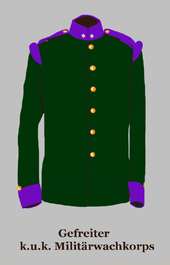kuk police guard corps
The Austro-Hungarian armed forces had their own police guard corps, which in peacetime consisted of the military police guard corps and the military guard corps for the kk civil courts in Vienna .
The Military Police Guard
They were originally set up to provide security services in the larger cities of the Austro-Hungarian monarchy. The competencies lay equally between the Austro-Hungarian Army and the Imperial and Royal Landwehr .
In the course of the 19th century, however, they were reduced more and more, so that in July 1914 they only consisted of three departments. The department commander was usually a captain , the ranks of the NCOs and men were: sergeant, platoon commander, corporal, vice-corporal and police soldier.
- Department of the Military Police Guard in Lviv : Commanding officer: Major Ritter Witold Dunin von Wascwicz
- Department of the Military Police Guard in Cracow : Commander: Captain Wenzel Kalik
- Department of the Military Police Guard in Przemyśl : Commander: Captain Gustav Skala
Adjustment
The members of the military police guard wore the shako , which could be provided with a black cover, based on the pattern of the infantry. For the crews there was also an officer's cap made of dark green cloth. The rose and cord were of yellow wool.
The tunic was made of dark green cloth with smooth yellow buttons with madder red leveling . The skirts for the NCOs and men were also designed according to the pattern of the infantry and equipped with armpit clasps (epaulettes) and shoulder bulges in equalizing color. The blouse used was also dark green and wore madder red Parolis . The passepoils on the blue-gray pantaloons were of the same color . As a service badge, the officers wore the field bandage, NCOs and men, however, a crescent-shaped ring collar, which was pressed from zinc sheet and provided with a number painted black on the polished front.
As a side arm, the NCOs and men carried the infantry saber with a brass basket, to which a leather hand strap was attached from the vice-corporal upwards. According to the adjustment regulations, officers wore the infantry officer's saber .
The military guard corps for the civil courts in Vienna
This corps was responsible for security and guard duty at the Viennese civil courts. It was roughly company strength and was subordinate to the Ministry of Justice, but disciplinary to the Ministry of War . The officer corps consisted of a captain and three subordinate officers. The ranks of the men and officers were: Sergeant, Fiihrer, Corporal, Private and Guard. Outfit (uniform) and adjustment corresponded to the military police guard corps, but the military guard corps was the only unit of the Austro-Hungarian army that carried a purple leveling.
The command was in Vienna IX. District in Viriotgasse 4. The commandant was Major Wilhelm Glieher.
Remarks
- ↑ All information relates to August 1914
literature
- Austrian State Archives / War Archives in Vienna (adjustment regulation for the Austro-Hungarian Army, Part III, Vienna 1911)
- Glenn Jewison, Jörg C. Steiner: The Austro-Hungarian Land Forces 1848-1918
- Johann C. Allmayer-Beck, Erich Lessing: The Kuk Army. 1848-1914 . Bertelsmann publishing house, Munich 1974, ISBN 3-570-07287-8 .
- Stefan Rest: The emperor's rock in the First World War . Verlag Militaria, Vienna 2002, ISBN 3-9501642-0-0
- The Austro-Hungarian Army in 1895 Writings from the Army History Museum in Vienna - Leopold Stocker Verlag , Graz 1997



